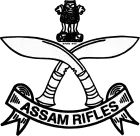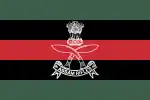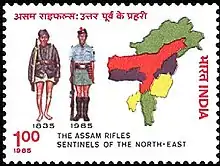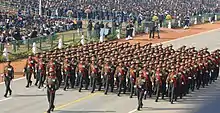Assam Rifles
The Assam Rifles (AR) is a central paramilitary force[5] responsible for border security, counter-insurgency, and maintaining law and order[6] in Northeast India. Its primary duty involves guarding the Indo-Myanmar border. The AR is one of the Central Armed Police Forces (CAPF) administered by the Ministry of Home Affairs. The Indian Army maintains its operational control. As a central police force, its recruitment, perks, promotions, and retirement policies are governed by CAPF rules.[7] Approximately 80 percent of the officers are deputed from the Army, while the remaining are drawn from the AR cadre.[8][9] The AR is commanded by the Director General of the Assam Rifles (DG AR), appointed by the Ministry of Home Affairs.[10]
| Assam Rifles | |
|---|---|
 Insignia of the Assam Rifles | |
 Flag of the Assam Rifles | |
| Abbreviation | AR |
| Motto | Friends of the Hill People Sentinels of the North East |
| Agency overview | |
| Formed | 1835 |
| Employees | 65,143[1] |
| Annual budget | ₹6658.41 crore (2022–23)[2] |
| Jurisdictional structure | |
| Federal agency | India |
| Operations jurisdiction | Northeast India, India |
 | |
| Map of Assam Rifles's jurisdiction | |
| Governing body | Ministry of Home Affairs |
| Constituting instrument |
|
| General nature | |
| Specialist jurisdictions |
|
| Operational structure | |
| Headquarters | Shillong, Meghalaya, India |
| Minister responsible | |
| Agency executive | |
| Parent agency | Central Armed Police Forces[2][4] |
| Website | |
| assamrifles | |
The AR is often nicknamed "Sentinels of the North East" and "Friends of the Hill People". It is the oldest paramilitary force in India, originally raised in 1835 as Cachar Levy, a militia to protect tea gardens and the fertile plains of Assam against unruly tribes. Its scope increased with the expansion of British Raj in Northeast India, and it was used against insurgencies in the region. The force was redesignated as Assam Frontier Police in 1883, Assam Military Police in 1891, and East Bengal and Assam Military Police in 1913.[11] It got its present name in 1917.[12] After independence, the AR functioned under the Ministry of External Affairs.[13] Its operational control was transferred to the Indian Army after the Sino-Indian War of 1962.[14] It came under the administration of Ministry of Home Affairs in 1965, with the Army retaining operational control.[13]
Throughout its history, the Assam Rifles have served in various conflicts and theaters, including World War I by serving in Europe and the Middle East, and World War II, where they served mainly in Burma. After the Chinese annexation of Tibet, the AR were tasked with manning Assam's section of the Tibetan border. They were also instrumental in maintaining law and order in Arunachal Pradesh.
As of the 2019–2020 report of the Ministry of Home Affairs, there are 46 battalions in the Assam Rifles with a sanctioned strength of 65,143 personnel.[15][16] They perform many roles including upholding internal security under the control of the army through the conduct of counterinsurgency and border security operations, provision of aid to civilians in times of emergency, and the facilitation of communications, medical assistance and education in remote areas.[17] In times of war they can also be used as a combat force to secure rear areas if needed. Since 2002, the force has had the role of guarding the India–Myanmar border.[18]
History

Early history
The present day Assam Rifles can trace its origins to a paramilitary force known as Cachar Levy which was established by the British in 1835 in the Assam region. The Assam Rifles boasts of being the oldest paramilitary force. With approximately seven hundred and fifty men, this force was formed as a police unit to protect settlements against tribal raids and other assaults as British rule slowly moved towards the north east parts of India.[15]
Despite problems with equipment and training, the contribution of this force in opening the region to administration and commerce was nevertheless quite significant and over time they have become known as the "right arm of the civil and [the] left arm of the military" in the region.[15] In 1870 these existing elements were merged into three Assam Military Police battalions which were spread out in the Lushai Hills (later 1st battalion), Lakhimpur (2nd battalion) and Naga Hills (3rd battalion). A fourth battalion was later formed Imphal in 1915. Following India's independence, Col. Sidhiman Rai, MC, was appointed the first Indian DG of Assam Rifles.
Since then the name of the force has undergone a number of changes, as have the roles that it has been required to perform.
World War I and Interwar years
During World War I, men from what was then known as the Assam Military Police were part of the Indian forces that fought in Europe and the Middle East. Over three thousand men from the force were provided to the Gorkha regiments of the Indian Army in this time, earning seventy-six gallantry awards during the conflict including seven Indian Order of Merit awards and five Indian Distinguished Service Medals.[15] These men performed with such distinction that the name Assam Rifles was assigned in 1917 as recognition of their part in the war.[15] Elements of the force were also utilised in India during the war, being used to maintain internal security in order to free up troops from the army for use overseas. During this time, the most notable action occurred in 1917 when columns of the Assam Rifles were despatched to Patna, to restore law and order in the riot-torn city.[15]
After the war the force returned to northern India where they were used to maintain security amidst growing civil unrest and disorder. In concert with the British Indian Army, they also undertook a number of expeditions into remote tribal areas along the north-east frontier and into Burma. In 1924 they were sent to Malabar, which was then still part of the Madras Presidency, to carry out operations against the Mopla rebels.[15]
World War II
During World War II, the role of the Assam Rifles evolved once more as they were called upon to undertake even more varied tasks due to their status as both a police and military organisation. This time, however, their service would be undertaken closer to home. After the lightning Japanese advance in 1942, the Assam Rifles fought a number of Independent actions behind enemy lines as the task of rear-area defence and rear-guard often fell to them during the Allies retreat into India. Later, as a large influx of refugees fled from the advancing Japanese into India, the Assam Rifles were given the task of managing and organising this mass of humanity.[15]
They also organized a resistance group on the Indo–Burmese border to counter the Japanese invasion and to harass the enemy line of communications. This group became known as "Victor Force" (or sometimes V-Force), and the nucleus of it was formed from platoons made up of men from the Assam Rifles. As part of this force, Assam Rifles platoons were used as covering forces during the latter stages of the Burma Campaign. Other elements fought in the defensive "boxes" around Kohima, whilst another, from the 4th Battalion, trained as airborne troops, was dropped near the Sittang River behind Japanese lines.[17] The 1st Battalion, as part of Lushai Brigade was sent ahead of the rest of the force to provide resistance in the Chin Hills. As a testament to the performance of Assam Rifles men during the war, members of the unit received forty-eight gallantry awards. These included: three MBE's, five Military Crosses, 4 Orders of British India, one Indian Order of Merit, 13 Military Medals, 15 Indian Distinguished Service Medals and 7 British Empire Medals.[15]

Postwar period
Following the end of the war the five Assam Rifles battalions became part of the civil police under the Assam Inspector General of Police.[17] After independence, however, the Indian government assigned the Assam Rifles its own Director General, who is sent on tenure based postings from the Indian Army.[15] As the numbers of the force and the number of battalions gradually increased, the rank of the force commander was upgraded to Director General, which is occupied by a lieutenant general ranking officer in the Indian Army. The present Director General of the Assam Rifles Pradeep Chandran Nair.[19]
Prior to 1965, this force was under the Ministry of External Affairs, who were looking after NEFA affairs. Later, it was transferred to the Ministry of Home Affairs, with Indian Army retaining operational control. From a nominal complement of only five battalions in 1947, it has grown to 33 with several range HQs. A training center, and a number of logistics units function under the HQ DGAR, Shillong.[20] The Assam Rifles Public School is a much sought after education institute in the North East.
The role of the Assam Rifles continued to evolve when in 1950 a devastating earthquake hit the Assam region and the force was called in to assist in the reconstruction of the areas and help in the resettlement and rehabilitation of those affected by it.[17] Later the force was once again called to undertake a combat role when, during the 1962 Sino-Indian War elements were used to delay the advancing Chinese forces so that the Indian Army could establish its defence lines.[15] During this time and since then, the Assam Rifles also maintained their peacekeeping role in the northern areas of India in the face of growing tribal unrest and insurgency. In this environment the maintenance of law and order, countering insurgency and reassuring the people of the region became important tasks for the security forces and initially they fell to the Assam Rifles before the Army assumed control, and then later their experience and goodwill in the region was drawn upon in order to assist the army in conducting these tasks.[15] In recognition of the unit's skill in counterinsurgency operations, three battalions were deployed on Operation Pawan in Sri Lanka between December 1988 and February 1990.[17]
Through its deployment in what has become known as the "tribal belt", the Assam Rifles have developed an ethos that is based primarily upon the notion of extending the hand of friendship with the people of the region despite the troubles that have occurred there.[15] This has resulted in their employment in a number of developmental activities in the region as they have worked to bring order and security to it. As such, their role has been further expanded to include the provision of medical assistance and basic education, assisting in reconstruction and agriculture and handling communications in remote areas.
From a force of 5 battalions in 1947, the Assam Rifles has grown substantially over the years. In 1960 there were 17 battalions, in 1968 there were 21 and today there are 46 battalions.[17] In addition, the force has several area HQs, a training centre that processes up to 1,800 recruits at time, and a number of logistics units.[21]
Organization
The Assam Rifles consists of a Director General Headquarter in Shillong, 3 Inspectorate General Headquarters, 12 Sector Headquarters, 46 Battalions, one Training Centre and administrative elements with a total authorized strength of 65,143 personnel.[22]
Organization structure
HQ DGAR
The Assam Rifles is commanded by an officer of the rank of Lieutenant General from the Indian Army, who is known as the Director General of the Assam Rifles (DG AR). The DG AR has their office at the HQ Directorate General of Assam Rifle at Shillong, unlike other Central Armed Police Forces which are located at Delhi.[23]
HQ IGAR
HQ Inspector General Assam Rifles comes next in chain of command after HQ MGAR. It is commanded by an officer of the rank of Major General from the Indian Army and exercises command and control over the sector HQs.
Sector HQ
The Sector HQ are commanded by Army Officers of the rank of Brigadier from the Army. The Sector HQ exercises direct command and control over the Assam Rifles Battalions deployed in its area of responsibility.
Maintenance Group Assam Rifles (MGAR)
The Maintenance Groups located at various location provide the requisite administrative support to the Assam Rifles formations and battalions deployed in the field. The MGAR are commanded by officers of the rank of Lieutenant Colonel from the Army.
Workshop
The workshop are co-located with the MGAR to provide repair and recovery cover to the field formations. These workshops further provide detachments to the Sector HQs to provide repair and recovery cover as far forward as possible to the battalions.
Areas covered
The areas covered by the Assam Rifle are themselves divided into sectors:
- Assam Rifles North – Kohima, Nagaland
- Sector 5 – Kohima, Nagaland
- Sector 6 – Dimapur, Nagaland
- Sector 7 – Tuensang, Nagaland
- Sector 25 – Lekhapani, Assam
- Assam Rifles South – Imphal, Manipur
- Sector 9 – Imphal, Manipur
- Sector 10 – Ukhrul South, Manipur
- Sector 26 – Thoubal, Manipur
- Sector 27 – Churchandrapur, Manipur
- Sector 28 – Thoubal, Manipur
- Assam Rifles East – Silchar, Assam
- Sector 21 – Agartala, Tripura
- Sector 22 – Haflong, Assam
- Sector 23 – Aizawl, Mizoram
- Assam Rifles Training Centre & School – Dimapur, Nagaland
OrBat
- 1 Kohima Battalion (1 Assam Rifles) IGAR North
- 2 Aizawl Battalion (2 Assam Rifles) (Second to none), Mizoram
- 3 Lunglei Battalion (3 Assam Rifles) IGAR East: Tuipang, Mizoram
- 4 Mantripukhri Battalion (4 Assam Rifles)
- 5 Dimapur Battalion (5 Assam Rifles)
- 6 Khonsa Battalion (6 Assam Rifles) IGAR North
- 7 Ghaspani Battalion(7 Assam Rifles) IGAR North
- 8 Chassad Battalion (8 Assam Rifles):
- 9 Changlang Battalion (9 Assam Rifles) IGAR North
- 10 Noney Battalion (10 Assam Rifles)
- 11 Haflong Battalion (11 Assam Rifles) (Double First) IGAR East
- 12 Joypur Battalion (12 Assam Rifles)
- 13 Sehlon Battalion (13 Assam Rifles) IGAR South
- 14 Chieswama Battalion (14 Assam Rifles)
- 15 Sajik Tampak Battalion (15 Assam Rifles) IGAR South
- 16 Keithelmanbi Battalions (16 Assam Rifles) IGAR South: Imphal East District, Manipur.
- 17 Lokra Battalion (17 Assam Rifles)
- 18 Agartala Battalion (18 Assam Rifles)
- 19 Jairampur Battalion (19 Assam Rifles) (Magnificent Nineteen)IGAR North
- 20 Tengnoupal Battalion (20 Assam Rifles) IGAR South
- 21 Modi Battalion (21 Assam Rifles)
- 22 Jwalamukhi Battalion (22 Assam Rifles) (Bais Bahadur)
- 23 Mokokchung Battalion (23 Assam Rifles) IGAR North
- 24 Shangshak Battalion (24 Assam Rifles)
- 25 Churachandpur Battalion (25 Assam Rifles)
- 26 Paribal Tekri Battalion (26 Assam Rifles) (Ujjawal Chhabbees)
- 27 Thoubal Battalion (27 Assam Rifles) (Magnificiant Hornbills)
- 28 Tuensang Battalion (28 Assam Rifles) IGAR North
- 29 Khoupum Battalion (29 Assam Rifles)
- 30 Joupi Battalion (30 Assam Rifles)
- 31 Loktak Battalion (31 Assam Rifles) IGAR South
- 32 Zunheboto Battalion (32 Assam Rifles) (Tenacious Thirtytwo)
- 33 Maram Battalion (33 Assam Rifles); Chandel District, Manipur
- 34 Wusan Battalion (34 Assam Rifles)
- 35 Somsai Battalion (35 Assam Rifles)
- 36 Jalukie Battalion (36 Assam Rifles) IGAR North
- 37 Phundrei Battalion (37 Assam Rifles) IGAR South
- 38 Shukhuvi Battalion (38 Assam Rifles)
- 39 Srikona Battalion (39 Assam Rifles B & D Coy)
- 40 Longding Battalion (40 Assam Rifles) IGAR North
- 41 Kiphire Battalion (41 Assam Rifles): Kiphire Dist, Nagalan
- 42 Serchhip Battalions (42 Assam Rifles) Mizoram
- 43 Moreh Battalion (43 Assam Rifles) IGAR South
- 44 Tamenglong Battalion (44 Assam Rifles) IGAR East
- 45 Shamator Battalion (45 Assam Rifles)
- 46 Khuga Battalion (46 Assam Rifles)
Decorations
Members of the Assam Rifles have received the following military decorations[24] -
- Pre - Independence Awards
- Post - Independence Awards
| Award | Times awarded |
|---|---|
| Ashoka Chakra | 4 |
| Param Vishisht Seva Medal | 10 |
| Kirti Chakra | 33 |
| Uttam Yudh Seva Medal | 1 |
| Ati Vishisht Seva Medal[25] | 23 |
| Vir Chakra | 5 |
| Shaurya Chakra[26] | 147 |
| Yudh Seva Medal | 12 |
| Sena Medal[27] | 400 |
| Vishisht Seva Medal[28] | 97 |
| Mentioned in dispatches | 39 |
Director General of Assam Rifles
The Director General Assam Rifles (DG AR) is the head of the Assam Rifles. The DG AR maintains an office in the Headquarters DG AR at Shillong. Appointed by the Government of India, the DG AR reports to the Minister of Home Affairs. The holder of this rank is a Lieutenant General-ranking officer of the Indian Army. The position is currently held by Pradeep Chandran Nair.
Rank structure
- Officers
| Rank group | General / flag officers | Senior officers | Junior officers | Officer cadet | ||||||||||||||||||||||||||||||||||||||||||||
|---|---|---|---|---|---|---|---|---|---|---|---|---|---|---|---|---|---|---|---|---|---|---|---|---|---|---|---|---|---|---|---|---|---|---|---|---|---|---|---|---|---|---|---|---|---|---|---|---|
|
 |
 |
 |
 |
 |
 |
||||||||||||||||||||||||||||||||||||||||||
| Inspector General[note 4] - |
Deputy Inspector-General[note 5] - |
Commandant[note 6] - |
Second-In-Command[note 7] - |
Deputy Commandant[note 8] - |
Assistant Commandant[note 9] - |
|||||||||||||||||||||||||||||||||||||||||||
- Enlisted ranks
| Rank group | Junior commissioned officers | Non commissioned officer | Enlisted | |||||||||||||||||||||||||||||||||
|---|---|---|---|---|---|---|---|---|---|---|---|---|---|---|---|---|---|---|---|---|---|---|---|---|---|---|---|---|---|---|---|---|---|---|---|---|
 |
 |
 |
No insignia | |||||||||||||||||||||||||||||||||
| Subedar Major सूबेदार मेजर |
Subedar सूबेदार |
Naib Subedar नायब सूबेदार |
Warrant officer - |
Havildar[note 10] हवलदार |
Rifleman[note 11] - | |||||||||||||||||||||||||||||||
Historic rank structure
- Enlisted ranks
| Rank group | Junior commissioned officers | Non commissioned officer | Enlisted | |||||||||||||||||||||||||||||||||
|---|---|---|---|---|---|---|---|---|---|---|---|---|---|---|---|---|---|---|---|---|---|---|---|---|---|---|---|---|---|---|---|---|---|---|---|---|
–2018 |
 |
 |
 |
No insignia | ||||||||||||||||||||||||||||||||
| Subedar Major सूबेदार मेजर |
Subedar सूबेदार |
Naib Subedar नायब सूबेदार |
Havildar हवलदार |
Naik नायक |
Lance Naik लांस नायक |
Sepoy सिपाही | ||||||||||||||||||||||||||||||
Tensions with Mizoram government
Various incidents have strained relations between Assam Rifles and the Government of Mizoram. In 2020, in a letter to the Ministry of Home Affairs, the Mizoram chief secretary reported a boycott of the Independence Day ceremony by the AR due to a dispute over seating order. The AR had objected to the state government's new Warrant of Precedence (WoP). It was also claimed that around 15 AR personnel violated COVID-19 protocols at the Vairengte border checkpoint. AR said that the state's home department was causing delays in permitting their troopers and supply vehicles to enter Mizoram, resulting in troopers being stranded at the Silchar railway station, and perishable supplies spoiled. In August, Champhai police registered an FIR against an unidentified AR personnel for an alleged molestation incident in a border village.[32]
An AR spokesperson stated that they had attended the ceremony, while senior officers abstained, citing a "downgrade" of their DIG rank in the state's WoP, contrasting the national order of precedence.[33] AR also alleged that the state government was disregarding the norms of the Ministry of Home Affairs by restricting movement of the forces.[34] However, the chief secretary argued that the AR had "no authentic reason" for boycotting since the DIG rank was elevated from an equivalent rank of additional secretary to that of secretary. The chief secretary's letter also accused the AR of handling civil administration with "insensitivity and contempt" and failing to acknowledge that "Mizoram is a peaceful state where the Armed Forces (Special Powers) Act, 1958 had long been withdrawn".[35]
See also
- Assam Regiment
- Border Security Force
- Central Industrial Security Force
- Central Reserve Police Force
- Indian Army
- Indo-Tibetan Border Police
- Ministry of Home Affairs (India)
- Ministry of Defence (India)
- National Security Guard
- Paramilitary forces of India
- Rashtriya Rifles
- Sashastra Seema Bal
- Special Forces of India
- Assam Rifles (football club)
Notes
- Also referred to by the rank Lieutenant general (लेफ्टिनेंट - जनरल)
- Also referred to by the rank Lieutenant general (लेफ्टिनेंट - जनरल)
- Also referred to by the rank Lieutenant general (लेफ्टिनेंट - जनरल)
- Also referred to by the rank Major general (मेजर - जनरल)
- Also referred to by the rank Brigadier (ब्रिगेडियर)
- Also referred to by the rank Colonel (कर्नल)
- Also referred to by the rank Lieutenant colonel (लेफ्टिनेंट - कर्नल)
- Also referred to by the rank Major (मेजर)
- Also referred to by the rank Captain (कप्तान)
- Also referred to by the rank Head constable (-)
- Also referred to by the rank Constable (-)
References
- "Annual Report Ministry of Home Affairs 2019–2020" (PDF). mha.gov.in. MHA. Retrieved 6 January 2022.
- "Rs 1.85 lakh crore allocation to MHA in budget". The Economic Times. Retrieved 1 February 2022.
- "Lt Gen Pradeep Chandran Nair takes over as DG of Assam Rifles". The Economic Times.
- "Central Armed Police Forces | Ministry of Home Affairs". Ministry of Home Affairs. Retrieved 1 November 2022.
- Singh, Soibam Rocky (6 September 2020). "HC asks Centre to decide on control over Assam Rifles". The Hindu. Retrieved 5 September 2021.
- "Section 4 in Assam Rifles Act, 2006". Indian Kanoon. Retrieved 1 November 2022.
- "MHA to explain functioning of Assam Rifles in northeastern states before Parliamentary panel". Asian News International. 25 May 2022. Retrieved 1 November 2022.
- Nathanael, M. P. (7 November 2019). "Changing the status quo". The Hindu. Retrieved 1 November 2022.
- Standing Committee on Home Affairs (12 December 2018). "Committee Reports". PRS Legislative Research. Retrieved 1 November 2022.
- Press Trust of India (24 August 2012). "Lt Gen Ranbir Singh appointed new DG of Assam Rifles". Business Standard. Retrieved 1 November 2022.
- Pant, Harsh V. (11 May 2020). The Routledge Handbook of Indian Defence Policy: Themes, Structures and Doctrines. Taylor & Francis. ISBN 978-1-000-07435-2. Retrieved 1 November 2022.
- News desk (13 November 2021). "From 'Cachar Levy' to Assam Rifles: All You Need to Know About India's Oldest Paramilitary Force". CNN-News18. Retrieved 1 November 2022.
- Singh, K. J. (29 September 2019). "Ain't broke? Don't fix: Assam Rifles delivers beyond expectations". The Times of India. Retrieved 1 November 2022.
- Tribune News Service (14 September 2019). "Assam Rifles may soon be merged with ITBP". Tribune India. Retrieved 1 November 2022.
- "History of the Assam Rifles". Archived from the original on 10 March 2009.
- "Annual Report Ministry of Home Affairs 2019-2020" (PDF). mha.gov.in. MHA. Retrieved 6 January 2022.
- Sharma 2008.
- "One Border One Force?". outlookindia.com.
- "Lt Gen Sukhdeep Sangwan takes over as DG of Assam Rifles". NORTHEAST NOW. 14 May 2018.
- "Organisation Structure". assamrifles.gov.in. Assam Rifles. Retrieved 6 January 2022.
Assam Rifles is a region specific force with its operational role in the North East and therefore the HQ DGAR is also located in the East. The HQs of all other Central Para Military Forces are located at Delhi.
- "Assam Rifles Training Centre". Archived from the original on 9 March 2009.
- "Annual Report Ministry of Home Affairs 2019-2020" (PDF). mha.gov.in. MHA. Retrieved 6 January 2022.
- "Organization Structure". assamrifles.gov.in. Assam Rifles. Retrieved 6 January 2022.
Assam Rifles is a region specific force with its operational role in the North East and therefore the HQ DGAR is also located in the East. The HQs of all other Central Para Military Forces are located at Delhi.
- "Honours & Awards". Retrieved 10 April 2021.
- There has been one instance of a multiple award of the AVSM to the same recipient, that is a 'Bar' being awarded. This is included in this figure.
- There has been one 'Bar' awarded for the Shaurya Chakra. This is included in this figure.
- There have been six 'Bars' awarded for the Sena Medal to members of the Assam Rifles. These are included in this figure.
- There has been one instance of a Bar being awarded for the VSM to a member of the Assam Rifles. This has been included in this figure.
- "असम राइफल्स विनियमन 2016 - Assam Rifles Regulation 2016" (PDF). 18 November 2016. Retrieved 20 August 2022.
- "Two Hundred Thirteenth Report - Security Situation in the North Eastern States of India" (PDF). Department-Related Parliamentary Standing Committee on Home Affairs. 19 July 2018. pp. 6–8. Retrieved 21 August 2022.
- "Two Hundred Thirteenth Report - Security Situation in the North Eastern States of India" (PDF). Department-Related Parliamentary Standing Committee on Home Affairs. 19 July 2018. pp. 6–8. Retrieved 21 August 2022.
- Hasmat, Karishma (4 September 2020). "Tensions soar between Assam Rifles & Mizoram govt, force faces apology deadline". The Print. Retrieved 26 August 2023.
- "'Assam Rifles Forgets AFSPA Not in Force Here': Mizoram to Centre as Standoff Continues". News 18. 26 August 2020. Retrieved 26 April 2023.
- Nath, Hemanta (21 August 2020). "Mizoram govt violating MHA guidelines by restricting entry of armed forces: Assam Rifles". India Today. Retrieved 27 August 2023.
- "Stand-off between Mizoram govt., Assam Rifles escalates". The Hindu. 26 August 2020. Retrieved 26 April 2023.
Bibliography
- Parker, John (2005). The Gurkhas: The Inside Story of the World's Most Feared Soldiers. Headline Book Publishing. ISBN 978-0-7553-1415-7.
- "History of the Assam Rifles". Retrieved 25 February 2009.
- "Assam Rifles Training Centre". Retrieved 25 February 2009.
- Shakespear, Leslie. (1929). History of the Assam Rifles. Macmillan: London. Reprinted in 1977 by Firma.
- Sharma, A.K. (2008). "The Assam Rifles: Sentinels of the East". Archived from the original on 19 May 2008. Retrieved 25 February 2009.

